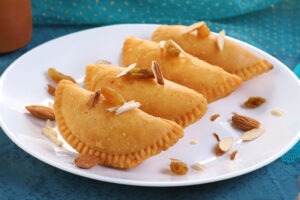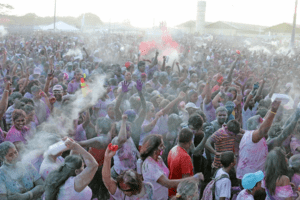Holi (pronunciation: /ˈhoʊliː/; Sanskrit: होली Holī) is a Hindu spring festival in India and Nepal, also known as the “festival of colours” or the “festival of love”. The festival signifies the victory of good over evil, the arrival of spring, end of winter, and for many a festive day to meet others, play and laugh, forget and forgive, and repair broken relationships, and is also celebrated as a thanksgiving for a good harvest. It lasts for two days starting on the Purnima (Full Moon day) falling in the Bikram Sambat Hindu Calendar month of Falgun, which falls somewhere between the end of February and the middle of March in the Gregorian calendar. The first day is known as Holika Dahan (हॊलिका दहन) or Chhoti Holi and the second as Rangwali Holi, Dhuleti, Dhulandi or Dhulivandan.
Holi is an ancient Hindu religious festival which has become popular with non-Hindus in many parts of South Asia, as well as people of other communities outside Asia. It is celebrated at the approach of the spring equinox, on the Phalguna Purnima (Full Moon). The festival date, which is determined by the Hindu calendar, varies from year to year on the Gregorian calendar, typically coming in March, sometimes in February. It is primarily observed in India, Nepal, and their diaspora in other regions of the world. In recent years the festival has spread to parts of Europe and North America as a spring celebration of love, frolic, and colours.
Holi celebrations start on the night before Holi with a Holika bonfire where people gather, do religious rituals in front of the bonfire, and pray that their internal evil should be destroyed as the bonfire starts. The next morning is celebrated as Rangwali Holi – a free-for-all carnival of colours, where participants play, chase and colour each other with dry powder and coloured water, with some carrying water guns and coloured water-filled balloons for their water fight. Anyone and everyone is fair game, friend or stranger, rich or poor, man or woman, children and elders. The frolic and fight with colours occurs in the open streets, open parks, outside temples and buildings. Groups carry drums and other musical instruments, go from place to place, sing and dance. People visit family, friends and foes to throw coloured powders on each other, laugh and gossip, then share Holi delicacies, food and drinks. Some customary drinks such as those that include bhang (marijuana) are intoxicating. In the evening, after sobering up, people dress up and visit friends and family.
Reference: Wikipedia







